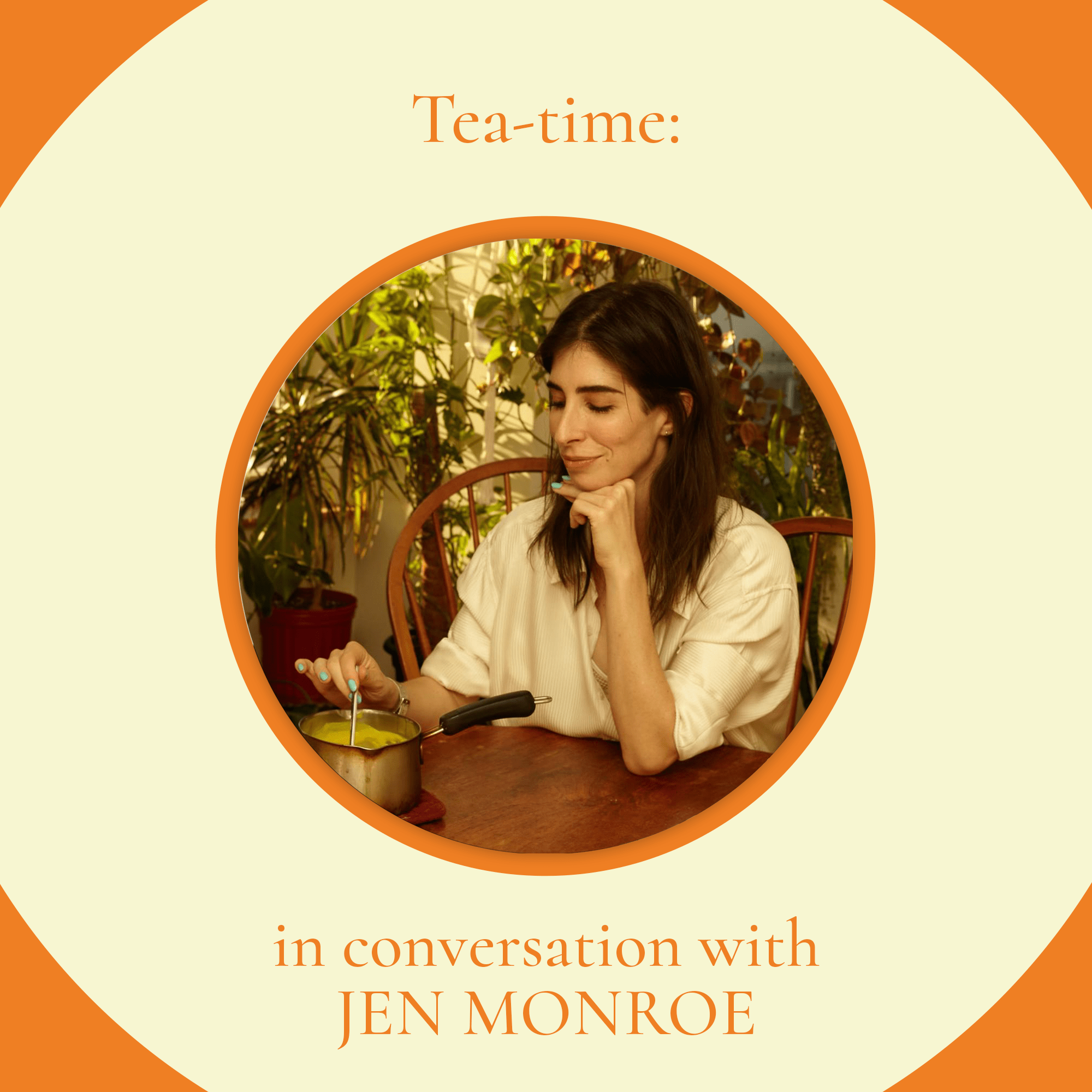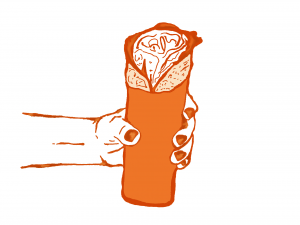
Tea-time: in conversation with Jen Monroe
by Mia Wu | December 10, 2022
Jen Monroe is a chef and artist whose project, Bad Taste, is committed to exploring new ways of thinking about food and consumption, approaching food as fantasy and as a transportive medium. Past work has included a dinner about the honey bee health crisis, a 100–square–foot edible map of New York City, food installations for fashion week presentations, experimental cotton candy, concept pop-up dinners, a rendering of a futuristic seafood menu in response to climate change, and a series of immersive, monochromatic ten–course ‘color meals’. Mia Wu interviews Monroe about the politics of music and food, and how she reflects this in her art.
Mia – I wanted to start by talking about music. You run Listen To This, a programme for NTS Radio. Do you think your music taste shifts over time?
Jen – It changes often. My listening habits follow a pretty clear seasonal genre pattern, so I’m glad that the title of my radio programme is temperature-related.
As soon as it starts getting colder, I do a couple of things. I go through this intense musical regression, finding myself drawn to the things I loved as a teenager – the musical equivalent of comfort food. I also veer towards things that are a little more folksy, more guitar-oriented and more organic. But in the summer, I steer towards fun and exuberant music.
Seven or eight years ago I was obsessed with musical research. It was a really exciting moment of digging to find forgotten records. And there was such an incredible treasure trove of these amazing Japanese 80s synth pop records that had never made it over to the States – but since then, there’s been a massive influx of interest in those genres, and reissue culture has gotten so crazy that it’s made it quite difficult to find any stones that have been left unturned. It feels like the Internet has scraped the bottom of the barrel with all the records that exist in the world, like the musical world has shrunk in a really significant way, but we also have so many options at our fingertips – it’s a paradox.
M – It’s true that, nowadays, there’s a sense of unlimited access to a wide variety of music. I wonder if you can relate that to your work with food? Particularly living in New York City, where, in my experience, food culture allows for access to an incredible diversity of options: mom-and-pop noodle shops next to ritzy French restaurants, next to smokey food trucks, next to corporate-ready refrigerated wraps. Is it exciting or off-putting?
J – You’re completely right, New York is an incredibly diverse food city, but there’s been a narrowing in which kinds of food we qualify as trendy or worth seeking out.
I think gentrification has played a huge role in that. If you take Manhattan’s Chinatown, maybe 15 years ago, you could just swim in extremely cheap, plentiful food, and none of it was getting written about in magazines. None of it was being commodified as something to sell to people in a chic, expensive way. Of course we want the people who have fought for this food, taught us about it and championed it to get their paychecks. But with a wave of rent hikes, people now can’t afford to live in the places their families did. Manhattan’s Chinatown is a completely different world to what it was five years ago. Even Flushing and Sunset Park are being gentrified.
It feels like we’re moving towards this commodified monoculture of taste. There’s this narrow slice of Sichuanese Chinese food which we’re told is trendy. But China is enormous, and there are hundreds of different cuisines that we only know a tiny little sliver about. In New York we think we’re experts, that we’re plural in our tastes, but when it comes to cultures that we’re not personally acquainted with, we mostly just know what’s been dictated to us by a small slice of food media culture.
It’s the same with music. I was talking to my boyfriend the other day about Taylor Swift’s new record. There’s been this undeniable phenomenon of millennial and Gen Z pop culture centering on Taylor Swift, and every time she releases a record there’s 10 new think-pieces about what an auteur she is. Like, “Isn’t it so incredible when a woman can turn her feelings into art?” But female musicians have been doing this for decades. Spotify creates a kind of monoculture: everyone is expected to love this Taylor Swift record, and these streaming platforms force them on you by dictating that these are the only things visible to us. This is what you love now. This is what is good now. It does feel like a narrowing of the playing field.
M – I feel like what you’re discussing is this idea about capitalism and the hyper-commodification of food and art. Does that tie into your piece for the Guild of Future Architects Summit, where you highlighted greenwashed corporations like Sweetgreen and Whole Foods? How they sell themselves as sustainable even though they really aren’t?
J – You’re right: these ideas of capitalism, food, and art are all connected. I want to be optimistic because we do live in a time where we have so much information available to us, especially regarding food and music. Never before have people had access to this many flavours, ingredients, cultures, and recipes – it’s all really exciting, even if it’s also overwhelming. And the same goes for music: we’ve never had access to so much, but at the same time the average person is listening to the same Spotify indie playlist all the time, and it feels largely devoid of personality. That mass-marketed non-descript pleasantness, which shows up in both food and music, is really changing the texture of our day-to-day lives.
To your point about it pertaining to capitalism: I would say that there’s no way to ethically consume under capitalism. And my choice to mostly work within food is based on an interest in what consumption looks like. The Guild of Future Architects Summit project was – a 100-square-foot edible map of New York City, which represented its different food systems, and it – invited consumers to play a game where they were scraping away the layers of food, and underneath it was an physical map of the city. So, as they’re eating, they’re slowly starting to realize, Okay, now I’m in Bensonhurst, now I’m in Flushing, now I’m at the airport. The landmarks that they were eating were part of the city. And that represented the act of complicity, because by living and being a human we are complicit in these capitalistic structures, whether or not we believe that they are good or whether you contributed to them.
New York obviously has so many food systems, but the ones which particularly appealed to me were these greenwashed food chains like Sweetgreen and Whole Foods. I always think back to Michael Pollan’s The Omnivore’s Dilemma, where he does a fascinating breakdown of the process of harvesting, cleaning, and shipping a bag of salad greens across the country, with its environmental toll of water, gas, and refrigeration. But when we buy a salad from Sweetgreen we’re not thinking about that – we’re giving ourselves a pat on the back for eating some vegetables rather than fast food. There’s something insidious about the fact that these big chains frame themselves as the solution to the food problem, when they come with a huge environmental price tag and are unavailable to so many swathes of people. Meanwhile, so many other restaurants can’t afford to pay rent in Manhattan. It’s so hard for mom-and-pop shops to thrive in places where rent is astronomically high, which creates this odd monoculture of options. And it’s really, really weird.
M – Completely. I wonder if you have any suggestions about counteracting all of this? When we live in this age of mass consumption and inescapable complicity in capitalistic structures, how can we think more intentionally about the ways in which we consume media and food? Do you have any thoughts about living life more slowly?
J – I wish I had a tidy solution, but I really don’t, because I feel just as enmeshed in all these funny solutions of convenience and cheapness. I wish I could say I’m a food influencer who only eats beautiful home-cooked meals and local produce, but my life isn’t shaped that way. I do a lot running around and schlepping large quantities of food around the city on my back and being hangry and overcaffeinated, even though my job is working with food. I think if you ask most chefs, they’ll tell you, Yeah, I eat like shit most of the time. I eat a lot of crap. My boyfriend and I are pretty good about cooking a nice dinner a couple times a week, but other than that I eat a lot of Chipotle and instant ramen.
At the end of the day the way most people’s lives are shaped makes it really hard to do things slowly. I think mindfulness is kind of a code word for a lot of confusing class structures. Because if you’re a single mom with three kids and two jobs, realistically you’re probably not in a position where you can cook a nice meal and enjoy the process of eating. Slowing down, “mindfulness,” these are all big luxuries.
I guess the only way I can speak to living life more slowly is that when I’m not working, I try to go out to fun new restaurants. A lot of the time, I’m so tired of cooking that cooking for myself is truly the last thing in the world that I want to do. I love when I’m able to take more space from it and have a break.
M – You’re completely right about how difficult it is for a single mom with three kids to think about food in the same way that, say, a corporate young professional in an Upper West Side apartment does – I guess that’s a question about scarcity and overindulgence, right? Food can be a means through which we think about inequality because we assume it to be a common resource, but it obviously isn’t in a global context. Can you speak a bit more about that?
J – As you mentioned, there’s obviously a massive amount of privilege that comes with being someone who can treat food as an art medium. But that’s what all chefs do, right? We have a great deal of privilege in being able to treat food with humour or deliberate frivolity, rather than treating it as a precious resource. It’s something that I think about all the time.
It’s also a question of who has to foot the bill for the climate destruction the Western world has inflicted upon everyone else. We live in a world that’s dictated by Western wellness culture and aesthetics – fun and funky millennial colours, smoothie bowls and beautiful condiments – and we generally don’t think about where these resources come from, how they were made, where they go when we throw them away. I just hope that I can make art that speaks to that in a meaningful way, to look at the ways in which food consumption is tied up in climate change and the destruction of ecosystems.
M – I’m really interested in what you said about Western wellness culture, and how food speaks to that. I think there’s an aspect of wellness culture which is intensely individualistic – the constant urge to present oneself through a certain aesthetic, whether it’s on social media or in day-to-day life. I wonder if you think there is any space amongst all of this for food to be something less individualistic and more communal? I mean, you talk about cooking a couple of meals a week with your boyfriend, and how that’s something that you cherish. How do you marry those two conflicting impulses: food as an individualistic, Western, capitalistic phenomenon, while also being something that can really, genuinely bring people together?
J – I think you really hit the nail on the head with the term individualistic, because we’re at this really weird point of food functioning as a means of self-identification, particularly on the internet. This is what my dinner looks like, therefore this is what kind of person I am, what income bracket I occupy, et cetera. To some extent, this has always been true: we think about elaborate medieval feasts and the way ancient Greeks ate, and obviously that stuff was coded in class and self-identification. It’s all totally divorced from the experience of eating itself.
It does feel like my generation and yours are moving away from the 1950s ideal of the family at the dinner table. Nuclear families don’t really look like that anymore. I didn’t grow up in one – my parents were divorced and worked full-time. Most people don’t grow up like that anymore. But that’s also not what we see on Instagram.
M – But – to push back – do you ever think about the ways in which your art can actually counteract this individualisation and create spaces to bring people together? I know that sounds kind of cheesy, but your work as a chef and as a DJ creates these spaces for connection. Are these not mediums which can form a kind of community again?
J – I don’t think that’s cheesy at all. I like to think there’s a universe where you can do both things at the same time: make work that is critical while still bringing people together. That’s a significant part of what attracted me to food and music in the first place: getting these emails during long periods of lockdown where people around the world would say, Hey, I’m listening to your show right now. That feeling of connection was a very small, simple saving grace.
With food as well, I think about that all the time: who’s going to be sitting at this table? What kind of conversations could they have with each other? How is this food meant to be in dialogue with the environment it’s consumed in? And that’s a really useful jumping-off point for thinking about gathering community around the shared experiences that happen around the table. I don’t think it’s a cheesy question at all. It’s very much always at the forefront of my mind. ∎
Interview by Mia Wu.




